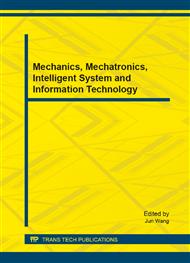[1]
J. Chen W.J. Bock, A Novel Fiber-Optic Pressure Sensor Operated at 1300-nm Wavelength, IEEE Transactions on Instrumentation and Measurement, 53(1), pp.10-12.
DOI: 10.1109/tim.2003.822011
Google Scholar
[2]
R.A. Sherry,S. M. Lord, LabVIEW as an Effective Enhancement to an Optoelectronic Laboratory Experiment, In Process Frontier Conference, 1997, p.897–900.
Google Scholar
[3]
M.Z. Zulkifli S.W. Harun,K. Thambiratna, Self-Calibrating Automated Characterization System for Depressed Cladding EDFA Applications using LabVIEW Software with GPIB, IEEE Transaction on Instrumentation and Measurement, vol. 57, no. 11, November 2008, pp.231-235.
DOI: 10.1109/tim.2008.925007
Google Scholar
[4]
A.W. Domanski,A. Gorecki,M. Swillo, Dynamic Strain Measurements by Use of the Polarimetric Fiber Optic Sensors, IEEE Journal of Quantum Electronics, 31(8), 2005, pp.816-821.
DOI: 10.1109/imtc.1995.515428
Google Scholar
[5]
N. Lagokos, L. Litovitz, P. Macedo, Multimode Optical Fiber Displacement Sensor, Applied Optic, Vol. 20, 2001, pp.167-172.
Google Scholar
[6]
S.K. Yao, C.K. Asawa, Fiber Optical Intensity Sensors, IEEE Journal of Selective Areas in Communication, SAC-1(3), 2003, pp.554-559.
Google Scholar
[7]
Kreso Zmak, Zvonimir Sipus, Petar Basic, A New Approach to Remote Fiber Testing in Optical Networks, 17th International Conference on Applied Electromagnettics and Communications, Croatia, 2003, pp.288-293.
DOI: 10.1109/icecom.2003.1291008
Google Scholar
[8]
S.W. Harun,K. Dimyati K.K. Jayapalan, An Overview on S-band Erbium-Doped Fiber Amplifiers, Laser Physics Letter, vol. 4, no. 1, 2007, pp.10-15.
DOI: 10.1002/lapl.200610064
Google Scholar
[9]
S.W. Harun, F. Abd Rahman, K. Dimyati, An efficient gain-flattened C-band erbium-doped fiber amplifier, Laser Physics Letter, vol. 3, no. 11, 2006, pp.536-538.
DOI: 10.1002/lapl.200610048
Google Scholar
[10]
N.M. Samsuri S.W. Harun, Comparison of Performances between Partial double-Pass and Full Double-Pass Systems in Two-Stage L-Band EDFA, Laser Physics Letter, vol. 1, no. 12, 2004, pp.610-612.
DOI: 10.1002/lapl.200410116
Google Scholar
[11]
R.T. Tamos, E.J. Fordham, Oblique-Tip Fiber-Optic Sensors for Multiphase Fluid Discrimination, Journal of Lightwave Technology, Vol. 17, No. 8, August 1999, p.335-p.340.
DOI: 10.1109/50.779160
Google Scholar


